The Seasonic PRIME Titanium PSU (650W, 750W, 850W) Review: Mythical Performance
by E. Fylladitakis on April 7, 2017 9:00 AM ESTHot Test Results
The electrical performance of the new Seasonic PRIME Titanium units is unbelievable. We are unsure how Seasonic even managed such power quality and performance figures.
| Seasonic SSR-650TD - Main Output | ||||||||
| Load (Watts) | 130.29 W | 325.85 W | 488.11 W | 650.38 W | ||||
| Load (Percent) | 20.04% | 50.13% | 75.09% | 100.06% | ||||
| Amperes | Volts | Amperes | Volts | Amperes | Volts | Amperes | Volts | |
| 3.3 V | 1.78 | 3.34 | 4.45 | 3.34 | 6.67 | 3.33 | 8.89 | 3.33 |
| 5 V | 1.78 | 5.03 | 4.45 | 5.03 | 6.67 | 5.01 | 8.89 | 5.01 |
| 12 V | 9.6 | 12.02 | 24.01 | 12.02 | 36.01 | 12.01 | 48.02 | 12 |
| Line | Regulation (20% to 100% load) |
Voltage Ripple (mV) | |||||
| 20% Load | 50% Load | 75% Load | 100% Load | CL1 12V |
CL2 3.3V + 5V |
||
| 3.3V | 0.2% | 4 | 4 | 6 | 8 | 4 | 6 |
| 5V | 0.25% | 4 | 6 | 6 | 8 | 4 | 6 |
| 12V | 0.15% | 4 | 4 | 6 | 8 | 6 | 6 |
| Seasonic SSR-750TD - Main Output | ||||||||
| Load (Watts) | 150.34 W | 375.71 W | 562.75 W | 750.4 W | ||||
| Load (Percent) | 20.05% | 50.09% | 75.03% | 100.05% | ||||
| Amperes | Volts | Amperes | Volts | Amperes | Volts | Amperes | Volts | |
| 3.3 V | 1.81 | 3.33 | 4.53 | 3.33 | 6.8 | 3.33 | 9.07 | 3.33 |
| 5 V | 1.81 | 5.02 | 4.53 | 5.02 | 6.8 | 5.01 | 9.07 | 5.01 |
| 12 V | 11.25 | 12.02 | 28.11 | 12.02 | 42.17 | 12 | 56.23 | 12 |
| Line | Regulation (20% to 100% load) |
Voltage Ripple (mV) | |||||
| 20% Load | 50% Load | 75% Load | 100% Load | CL1 12V |
CL2 3.3V + 5V |
||
| 3.3V | 0.2% | 4 | 4 | 6 | 8 | 4 | 6 |
| 5V | 0.25% | 4 | 6 | 6 | 10 | 4 | 6 |
| 12V | 0.18% | 4 | 4 | 6 | 8 | 6 | 8 |
| Seasonic SSR-850TD - Main Output | ||||||||
| Load (Watts) | 170.49 W | 426.27 W | 638.38 W | 851.07 W | ||||
| Load (Percent) | 20.06% | 50.15% | 75.1% | 100.13% | ||||
| Amperes | Volts | Amperes | Volts | Amperes | Volts | Amperes | Volts | |
| 3.3 V | 1.84 | 3.34 | 4.6 | 3.34 | 6.91 | 3.33 | 9.21 | 3.33 |
| 5 V | 1.84 | 5.04 | 4.6 | 5.04 | 6.91 | 5.02 | 9.21 | 5.02 |
| 12 V | 12.89 | 12.03 | 32.23 | 12.03 | 48.35 | 12.01 | 64.46 | 12.01 |
| Line | Regulation (20% to 100% load) |
Voltage Ripple (mV) | |||||
| 20% Load | 50% Load | 75% Load | 100% Load | CL1 12V |
CL2 3.3V + 5V |
||
| 3.3V | 0.2% | 4 | 4 | 6 | 8 | 4 | 8 |
| 5V | 0.25% | 4 | 6 | 8 | 10 | 6 | 8 |
| 12V | 0.15% | 4 | 4 | 8 | 10 | 8 | 6 |
We had to check our readings down to the fourth decimal point, as the voltage regulation on the main 12V line is below 0.15%, meaning that a cheap 2-decimal point voltmeter might not even display a difference at all across the entire load range. The 3.3V/5V lines are a little less tightly regulated but still remain amongst the most stable that we have ever seen, with our worst result being 0.24% for the 5V line of the 850W model.
The power quality of all three PRIME Titanium units is insanely good, with our oscilloscope never reading a voltage ripple above 10mV under any operating conditions. We have never seen such effective filtering before on consumer level products.
Despite the exceptional efficiency of the PSUs, the fans are significantly more lively with the units operating into our hotbox, as the thermal control circuit is trying to maintain low internal operating temperatures. The PRIME Titanium units all begin with noise figures when lightly loaded but their fans will keep increasing their speed alongside with the load, reaching clearly audible figures with loads above 300 Watts and even becoming noisy with >46 dB(A) figures when they units are very heavily loaded. The maximum temperature that our instruments recorded was just below 80 °C, which is very low for an 850W PSU operating at maximum capacity, meaning that Seasonic could trade some of the thermal performance for better acoustics. These units do come with a 12-year warranty though, so the designer could perhaps not afford >90°C figures appearing into any of these units.



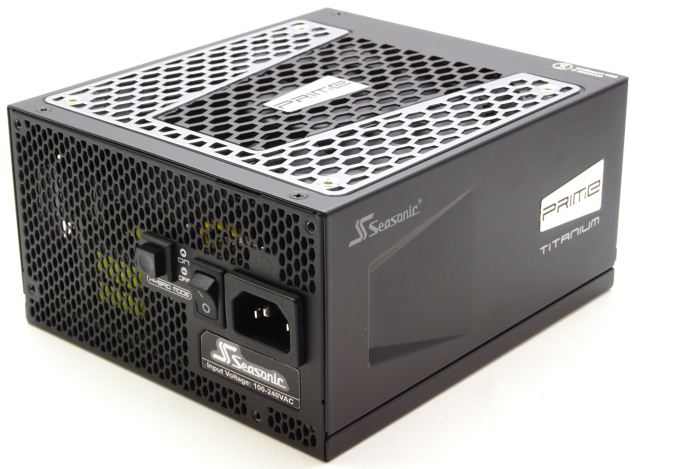
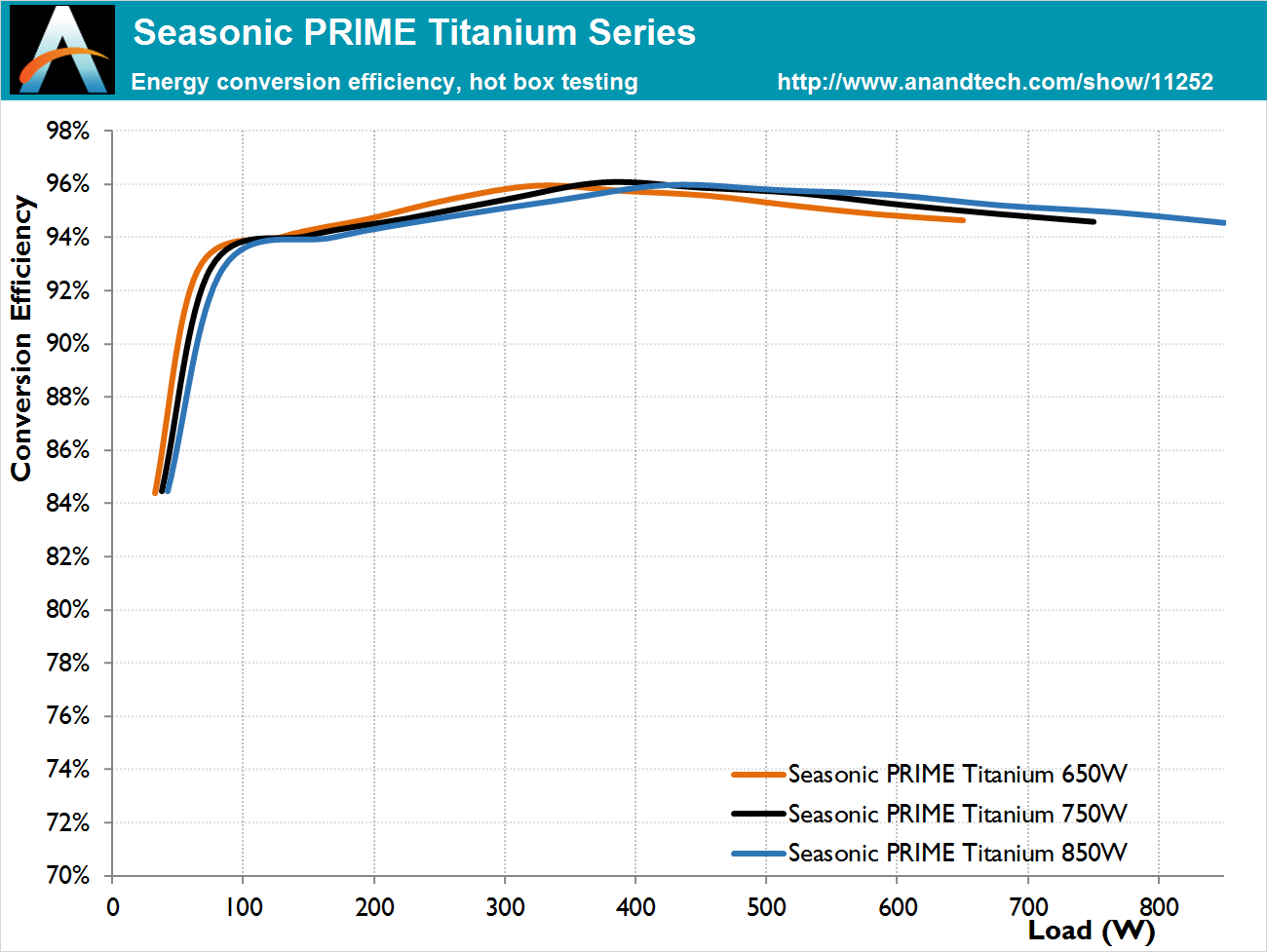
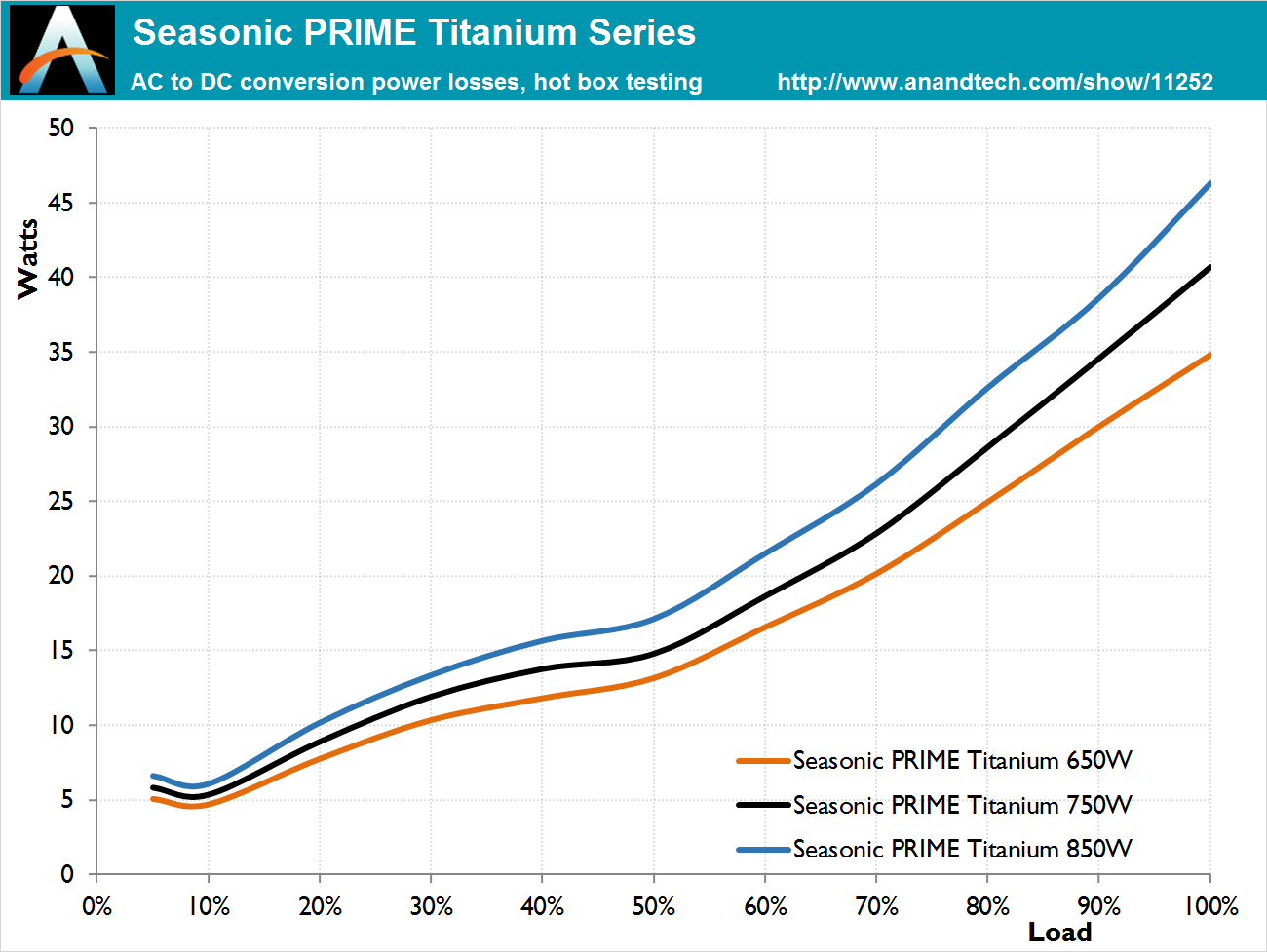

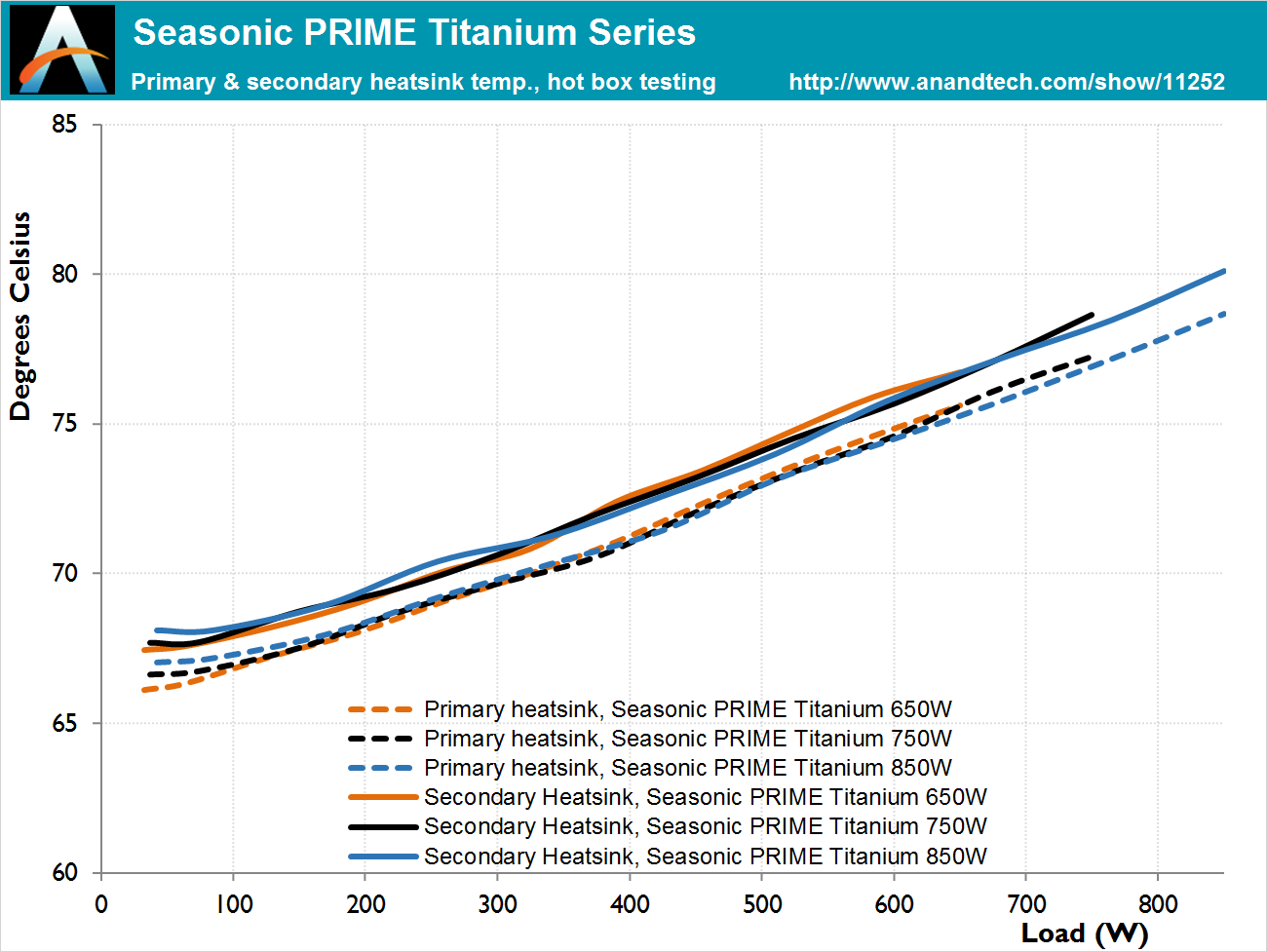
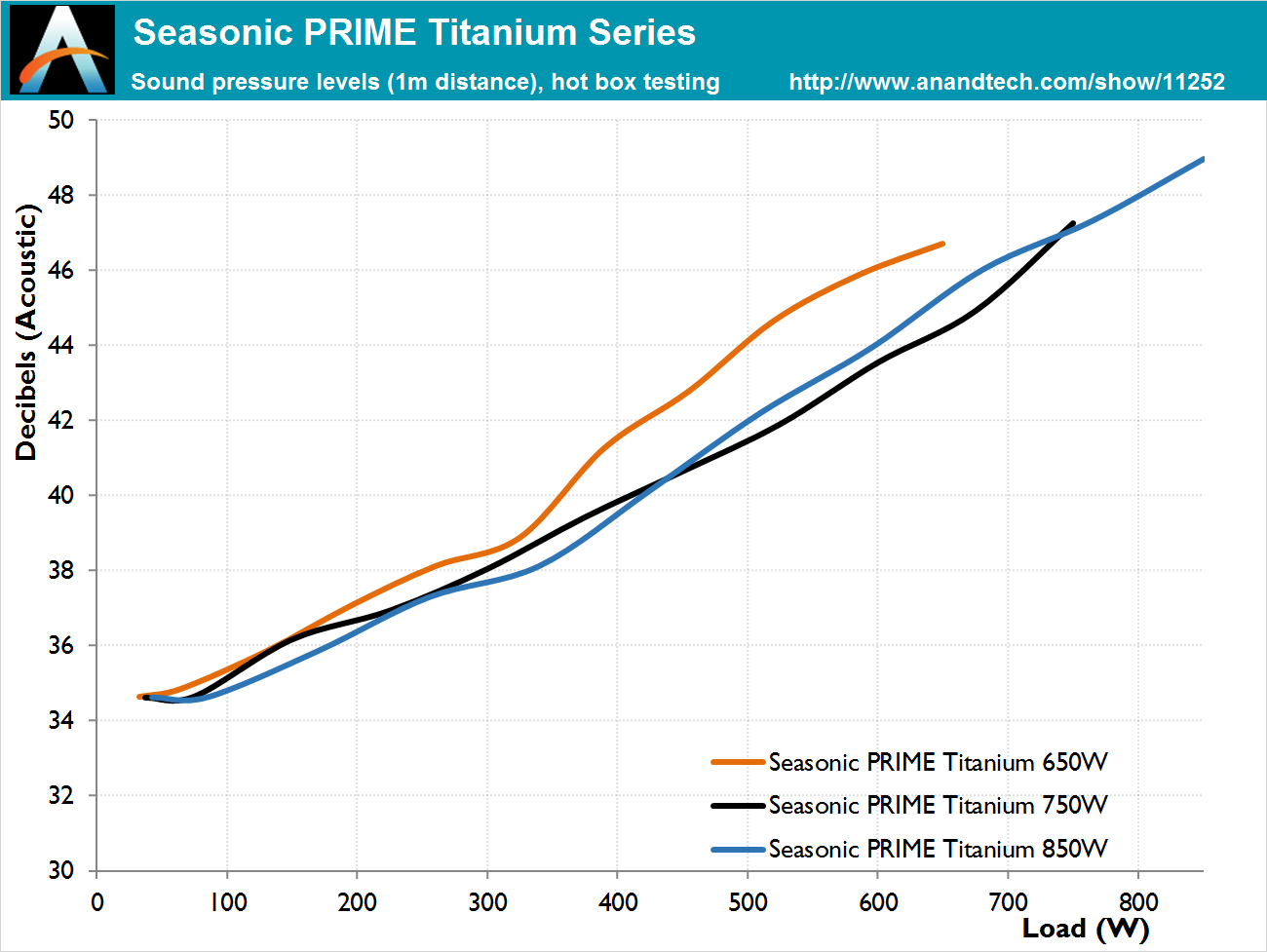








86 Comments
View All Comments
Jammrock - Friday, April 7, 2017 - link
I've had the 650W version since Oct 2016. It's powering an i7-6700K with a GTX 1080. Absolutely zero issues so far. It's quiet and efficient and solid. Can't recommend it enough. If the price tag fits within budget....My only gripe is the motherboard power cable. It's a split cable and kind of annoying to deal with. But then you only need to mess with it once per motherboard upgrade so really it's a very minor issue.
close - Friday, April 7, 2017 - link
Just out of curiosity, why didn't you go for the 750W if the price difference is just $5? Is it for efficiency reasons (less efficient than the 650W at your system's typical load)?Bullwinkle J Moose - Friday, April 7, 2017 - link
Low load efficiency was the reason I purchased a 350 Watt Seasonic SSR-350ST from newegg a few days ago instead of the SS-520GB or the SS-620GB @ B&H Photo for the same price when they were on sale last weekI wish you would cover power supply replacements for Monitors sometime
Had a standard 19 Volt LG power supply crap out last month and the only replacements I could find are basically CRAP
A T-Power replacement actually MELTED within 3 days and became non-functional before it had a chance to burn the house down
Other online stores for Monitor power supplies are complete scams selling more Chinese CRAP instead of the original equipment listed in their ads
I ended up using a VERY Old 120 Watt - 15 Volt Athena Laptop power supply with the T-Power Plug spliced to it's output
It works fine on 19 Volt LG's and cost about $30 around 10 years ago
I was a bit worried about EBay replacements for LG supplies but may need to try that route next time unless anyone knows where to buy "QUALITY" supplies with output current rated "above" what the stock LG's put out
Computer Power supplies are well covered at all the tech sites...
Monitor Supplies are never covered
Why is that?
Bullwinkle J Moose - Friday, April 7, 2017 - link
Modular cable outputs for 2 or 3 computer monitors on the back of these computer power supplies would be nice!I'd buy THAT!
alin - Friday, April 7, 2017 - link
Most laptop psu's are 18-20v. Plenty of them around :)Grimmm - Friday, April 7, 2017 - link
When I was overclocking a Korean IPS I bought a high power brick designed for medical applications on an online industrial parts catalog. Cost a bit, but works perfectly (after swapping the output connector)Jammrock - Tuesday, April 11, 2017 - link
@close - Two reasons. 1) At the time the 750W was more than a $5 difference. I purchased mine >6 months ago. 2) I try to size my PSUs to the load so they hit the peak of efficiency for the majority of my tasks. Granted, the difference is minimal for this particular 80Plus Titanium PSU, but old habits die hard.Sparkyman215 - Friday, April 7, 2017 - link
Wow. I've read a lot of your psu reviews, and I don't think you've used the words 'insanely good', 'unbelievable' - and of course 'mythical'. Even though the price is high, getting one of these and keeping it through upgrades for over a decade is probably a better deal than a lower end psu you have to replace several timesblahsaysblah - Friday, April 7, 2017 - link
It's pretty disheartening to think that they wont be modernizing either the cable layout/connectors or any other aspect of the PSU. It would be great if they could make things smaller/more direct. With the move to a single 12v rail, you would think they would move to single hot/ground per CPU/GPU connector. They have changed the insides a bit. Why there isnt some sort of data/status connector between PSU and MB... At very least to communicate PSU temps, but to add voltage,.. info, instead of all those sense cables.JasperJanssen - Saturday, April 8, 2017 - link
Moving to single wire bundles wouldn't gain you anything, and in fact loses you things. The reason there's 2 or 3 wires in those pcie bundles is current capability -- both for the connector and for the wires. So you still need the same amopunt of copper (actually, slightly more) to do that, if you move to having single wires instead of doubled. but those wires are going to be stiffer and more expensive. In other words, that's a bad idea.And re Status connectors -- while Seasonic could unilaterally add something custom, how many motherboard companies do you think would put a matching connector on? Also, the only thing that even *can* be monitored inside a PSU is the fan speed. That's why they occasionally had a fan speed wire coming out, which you can put on a motherboard fan connector. Only nobody ever used that function.
There just isn't any digital logic inside a PSU to communicate with. Motherboards can monitor voltages just fine on their own through the ATX connector.
(also, changing the connector type requires changing both the power supply *and* the GPU, which is awful.)